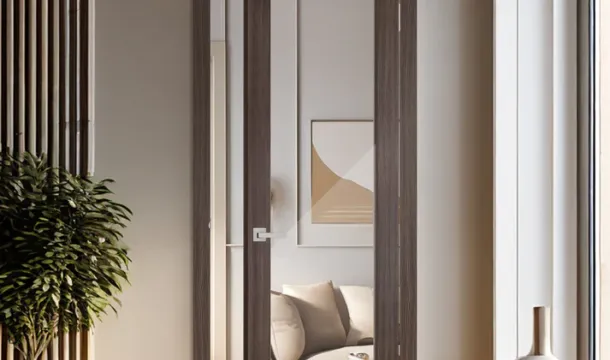Impact of Canadian Seasonal Changes on Interior Door Materials
Popular Articles
Wooden panels require careful selection and maintenance due to varying humidity levels throughout the year. High moisture during spring and fall often causes swelling, leading to misalignment or sticking frames. Opt for engineered wood or properly kiln-dried hardwood with stable moisture content to minimize these issues.
Metal doors, particularly those with insulated cores, show greater resistance against warping and moisture absorption but can be prone to condensation when indoor humidity is high. Ensuring proper ventilation reduces the risk of rust and prolongs lifespan.
During harsh winters, extremely low humidity may cause certain composites or solid wood variants to dry out and develop cracks or gaps around edges. Applying seasonal treatments such as sealants designed for cold climates helps maintain integrity and appearance over time.
When choosing entryways within homes located in regions with pronounced environmental swings, prioritize materials with dimensional stability and moisture resistance. Regular monitoring of indoor humidity coupled with appropriate finishes extends durability and preserves functionality through diverse weather conditions.
Moisture Effects on Wood Doors
Maintaining indoor humidity levels between 30% and 50% minimizes warping and swelling in wooden doors. Wood naturally absorbs moisture from the air, causing dimensional changes that can lead to misalignment or sticking. Monitoring humidity with a hygrometer and using dehumidifiers or humidifiers accordingly prevents excessive expansion or contraction.
Oak, maple, and cherry exhibit moderate sensitivity to moisture fluctuations, whereas softer woods like pine are more prone to deformation under high humidity. Applying a quality sealant on all door surfaces?€"including edges?€"reduces water absorption and prolongs structural integrity.
Practical Measures for Moisture Control
Ensure proper ventilation in rooms with fluctuating humidity such as kitchens and bathrooms. Installing exhaust fans helps lower ambient moisture, protecting wood components. Avoid direct contact between wood doors and wet floors or walls by maintaining clearance of at least 1/8 inch.
Signs of Moisture Damage and Remediation
Common indicators include surface cupping, cracking along grain lines, and difficulty in opening or closing panels. If damage occurs, lightly sanding affected areas followed by refinishing can restore functionality. In severe cases, replacing swollen sections might be necessary to maintain door performance.
Temperature Fluctuations and Door Warping
Maintaining stable indoor temperatures between 18°C and 22°C significantly reduces the risk of door warping caused by thermal expansion and contraction. Rapid temperature swings cause differential movement within wood fibers, leading to twisting or cupping, especially in solid hardwood doors.
Doors constructed from engineered wood or composite materials demonstrate greater resistance to deformation under fluctuating heat conditions due to their layered structure, which balances internal stresses more effectively than natural timber.
Consistent humidity control around 40-50% complements temperature management by minimizing moisture absorption variations that exacerbate dimensional changes. Installing programmable thermostats paired with humidifiers or dehumidifiers can stabilize environmental factors affecting door shape.
Avoid placing wooden doors near direct heat sources such as radiators or vents, as localized heating accelerates uneven drying and increases warping potential. Additionally, sealing door edges with weather-resistant finishes limits moisture exchange and thermal impact on vulnerable surfaces.
Regular inspection for early signs of distortion?€"such as gaps at the top or bottom when closed?€"allows timely intervention before permanent damage occurs. Sanding minor warped sections and reapplying finish can restore proper alignment if detected early enough.
Choosing Weather-Resistant Door Finishes
Select finishes with high resistance to fluctuating humidity levels to maintain structural integrity and appearance. Polyurethane coatings, especially those labeled as water-based, offer excellent protection without yellowing over time. They create a durable barrier that prevents moisture absorption, reducing the risk of swelling and surface degradation.
Oil-based varnishes provide deep penetration into wood fibers, enhancing water repellency while preserving natural grain texture. However, they require longer drying times and regular maintenance to ensure continued effectiveness against moisture variations.
Waterborne acrylic finishes combine flexibility with toughness, adapting well to expansion and contraction caused by temperature shifts. Their fast drying properties allow for multiple coats within a day, improving build thickness and resistance to wear from indoor humidity fluctuations.
For painted surfaces, select high-quality enamel paints with mildew-resistant additives and elastomeric qualities. These paints accommodate minor movements in the substrate without cracking or peeling, vital for environments experiencing seasonal swings in moisture content.
Regular application of penetrating sealers on raw wood doors enhances weatherproofing by filling microscopic pores where humidity could otherwise infiltrate. Sealers containing siloxane compounds are particularly effective at repelling water vapor while allowing the wood to breathe.
Maintenance frequency depends on local indoor climate control; homes lacking consistent dehumidification may require refinishing every 3?€"5 years to sustain optimal protection. Monitoring door surface condition will help identify early signs of finish failure such as dullness or raised grain.
Seasonal Maintenance for Door Longevity
Maintain optimal humidity levels between 35% and 55% indoors to prevent swelling or shrinking of wooden surfaces. Use humidifiers during dry winter months and dehumidifiers in humid summer periods to stabilize moisture content.
Inspect seals and weatherstripping quarterly to ensure airtight closure. Replace any cracked or hardened strips promptly to minimize air infiltration that accelerates material fatigue.
- Lubricate Hinges and Hardware: Apply silicone-based lubricants every three months to prevent rust and ensure smooth operation despite temperature swings.
- Refinish Protective Coatings: Evaluate finishes annually, focusing on edges where wear appears first. Sand lightly and apply a high-quality polyurethane or varnish designed for fluctuating indoor climates.
- Monitor Alignment: Check door fit for gaps or rubbing caused by seasonal expansion or contraction. Adjust hinges or strike plates as necessary to maintain proper function without forcing movement.
Avoid placing heat sources like radiators directly beneath door frames, as localized drying can cause uneven warping. Instead, position heating elements at a safe distance to promote gradual moisture redistribution.
Regularly clean surfaces with mild detergents and soft cloths; harsh chemicals strip protective layers, increasing vulnerability to humidity variations. For stubborn dirt, use pH-neutral cleaners specifically formulated for wood finishes.
- Schedule professional inspections every two years for doors exposed to extreme interior climate fluctuations.
- Install door sweeps or thresholds if drafts are detected, enhancing thermal efficiency while reducing moisture ingress.
- Avoid prolonged exposure to direct sunlight through windows, which can degrade finishes unevenly and alter dimensional stability over time.
Material Comparison for Humid Conditions
For environments with elevated humidity, engineered wood doors outperform solid wood in dimensional stability and resistance to swelling. Materials like medium-density fiberboard (MDF) combined with moisture-resistant adhesives maintain shape better, reducing the risk of warping or cracking.
Fiberglass doors offer superior resistance to moisture absorption due to their non-porous surface, making them ideal for rooms prone to high humidity such as bathrooms and basements. Their composite core prevents internal expansion, preserving structural integrity over time.
Solid hardwoods such as oak or maple absorb more moisture, which can cause cupping and splitting unless properly sealed with multiple coats of high-quality water-resistant finishes. Without this protection, these woods tend to degrade faster under persistent dampness.
Vinyl-clad options provide a low-maintenance alternative with excellent humidity tolerance. The vinyl exterior acts as a barrier against moisture infiltration but requires attention to door edges and seams where water may penetrate.
Ultimately, selecting materials engineered for moisture resilience?€"like MDF with specialized coatings or fiberglass composites?€"ensures longer service life in humid atmospheres while minimizing maintenance frequency and repair costs.
Popular Articles

Soundproofing Interior Doors: Which Options Are Best for Your Home?

Choosing the Perfect Interior Doors for Your Canadian Home
